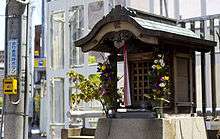Wayside shrine
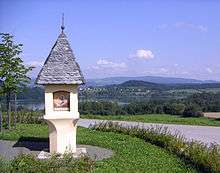
A wayside shrine is a religious image, usually in some sort of small shelter, placed by a road or pathway, sometimes in a settlement or at a crossroads, but often in the middle of an empty stretch of country road, or at the top of a hill or mountain. They have been a feature of many cultures, including Catholic Europe and Japan.
The origins of wayside shrines
Wayside shrines were often erected to honor the memory of the victim of an accident, which explains their prevalence near roads and paths; in Carinthia, for example, they often stand at crossroads. Some commemorate a specific incident near the place; either a death in an accident or escape from harm. Other icons commemorate the victims of the plague. The very grand medieval English Eleanor crosses were erected by her husband to commemorate the nightly resting places of the journey made by the body of Queen Eleanor of Castile as it returned to London in the 1290s. Some make it clear by an inscription or notice that a specific dead person is commemorated, but most do not.
Wayside shrines were also erected along old pilgrim routes, such as the Via Sacra that leads from Vienna to Mariazell. Some mark parish or other boundaries, such as the edge or a landholding, or have a function as convenient markers for travelers to find their way. Shrines and calvaries are furthermore frequently noted on maps and therefore represent important orientation aids.
Europe
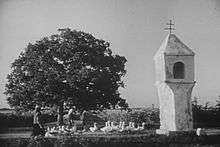
The pre-Christian cultures of Europe had similar shrines of various types; many runestones may have fallen into this category, though they are often in the nature of a memorial to a dead person. Few Christian shrines survive in predominantly Protestant countries, but they remain common in many parts of Catholic and Orthodox Europe, often being repaired or replaced as they fall into disrepair, and relocated as roads are moved or widened. The most common subjects are a plain cross or a crucifix, or an image of the Virgin Mary, but saints or other scenes may also be shown. The surviving large stone high crosses of Celtic Christianity, and the related stone Anglo-Saxon crosses (mostly damaged or destroyed after the Protestant Reformation) are sometimes outside churches, but often not, and these may have functioned as preaching crosses, or in some cases just been wayside shrines. The calvaires of Brittany in France, are especially large stone shrines showing the Crucifixion, but these are typically in villages.
Types of shrines
Wayside shrines are found in a variety of styles, ranging from simpler column shrines and Schöpflöffel shrines to more elaborate chapel-shrines. Some have only flat painted surfaces, while other shrines are decorated with reliefs or with religious statues. Some feature a small kneeling platform, so that the faithful may pray in front of the image. A common wayside shrine seen throughout the Alpine regions of Europe, especially Germany, Austria and northern Italy, is the Alpine style crucifix wayside shrine. This style often has elaborate wood carvings and usually consists of a crucifix surrounded by a roof and shelter.
Column shrines
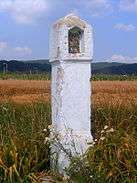
A column shrine[1] (German: Bildstock, also Marterl, Helgenstöckli, or Wegstock; Slovene: slopno znamenje) normally resembles a pole or a pillar, made either of wood or of masonry, and is sometimes capped with a roof.[2] The Austrian/south German designation Marterl hearkens back to the Greek martyros 'martyr'. In a setting resembling a tabernacle, there is usually a picture or a figure of Christ or a saint. For this reason, flowers or prayer candles are often placed on or at the foot of the shrine.
In Germany, they are most common in Franconia, in the Catholic parts of Baden, Swabia, in the Alpine regions and Catholic areas of the historical region of Eichsfeld and in Upper Lusatia. In Austria, they are to be found in the Alpine regions, as well as in great numbers in the Weinviertel, the Mühlviertel and in the Waldviertel. There are also similar structures in the South Bohemian Region and the South Moravian Region. In Czech, column shrines are traditionally called "boží muka" (= divine sufferings).
Schöpflöffel shrines
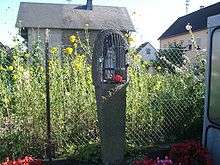
In the Eifel in particular, shrines that consist of a pillar with a niche for a depiction of a saint are known as Schöpflöffel (German for 'ladle' or 'serving spoon'). Some of these icons date from the Late Middle Ages, but for the most part were put up in the 16th century.
Near Arnstadt in Thuringia, there is a medieval shrine that is over two metres tall and that has two niches. According to a legend recorded by Ludwig Bechstein, this shrine was once a giant’s spoon, and it is therefore known as the Riesenlöffel.
Chapel-shrines
Chapel-shrines, built to resemble a small building, are common in Slovenia. They are generally too small to accommodate people and often have only a niche (occasionally, a small altar) to display a depiction of a saint. The main two varieties generally distinguished in Slovenia are the open chapel-shrine (Slovene: kapelica odprtega tipa, odprti tip kapelice), which has no doors, and the closed chapel-shrine (kapelica zaprtega tipa, zaprti tip kapelice), which has a door.[3] The closed chapel-shrine is the older form, with examples known from the 17th century onward. The earliest open chapel-shrines date from the 19th century.[4] Also known in Slovenia are the belfry chapel-shrine (kapelica - zvonik) and the polygonal chapel-shrine (poligonalna kapelica).[5]
Chapel-shrines, known as kapliczka, are also often found in Poland.
In the Czech Republic, chapel-shrines are called výklenková kaple 'niche chapels' and are characterized as a type of chapel (kaple) in Czech.[6] In Moravia, they are also called poklona 'bow, tribute'.
Gallery
 A shrine to the east of Pubersdorf in Austria
A shrine to the east of Pubersdorf in Austria

 A shrine in Hesselbach, Germany
A shrine in Hesselbach, Germany Shrine "Leixnertaferl" near Neustadt an der Donau in Lower Bavaria
Shrine "Leixnertaferl" near Neustadt an der Donau in Lower Bavaria
References
- ↑ Leary, James P. 1998. Wisconsin Folklore. Madison: University of Wisconsin Press, p. 451.
- ↑ Reallexikon zur deutschen Kunstgeschichte. - II. Band Bauer-Buchmalerei, S. 698, Uni München accessed 26 November 2008 (in German)
- ↑ Zadnikar, Marijan. 1970. Znamenja na Slovenskem: Risbe je naredil Ignacij Vok. Ljubljana: Slovenska matica, pp. 26, 28.
- ↑ Omerzu, Rozika. 1964. "Marijan Zadnikar, Znamenja na Slovenskem. Izdala in založila Slovenska matica, Ljubljana 1964." Book review. Kronika: časopis za slovensko krajevno zgodovino 12(2), p. 144.
- ↑ Skok, Barbara. 1985. "Tipi in razvoj znamenj na Loškem ozemlju - Selška dolina." Loški razgledi 32: 44-62, p. 45.
- ↑ Kaple s interiérem a výklenkové, Lidová architektura – Encyklopedie architektury a stavitelství
External links
- Wayside shrine (Polish)
| Wikimedia Commons has media related to Wayside shrines. |
